While some might dismiss snickerdoodles as just another sugar cookie, I’ve discovered there’s something undeniably special about these cinnamon-dusted treasures. As a professional baker, I’ve crafted countless variations, but I always return to this vegan recipe that captures the classic’s distinctive charm. The cream of tartar isn’t just tradition—it’s the secret behind that subtle tang and pillowy texture that sets these cookies apart from their sugar cookie cousins.
Let me share how these humble ingredients transform into something that’s earned a permanent spot in my recipe collection and just might surprise you.
Recipe
Vegan snickerdoodles are a delightful twist on the classic cinnamon-sugar coated cookies that have been beloved for generations. These dairy-free treats maintain the signature crackled surface and chewy interior that make traditional snickerdoodles so irresistible.
The secret to achieving the perfect vegan snickerdoodle lies in the combination of cream of tartar and baking soda, which creates the distinctive tangy flavor and helps develop those characteristic cracks on the surface. When paired with the warming notes of cinnamon and vanilla, these cookies produce the same nostalgic aroma and taste that made the original version a household favorite.
- 2 cups all-purpose flour
- 1 teaspoon cream of tartar
- 1/2 teaspoon baking soda
- 1/4 teaspoon salt
- 1/2 cup vegan butter, softened
- 3/4 cup granulated sugar
- 1/4 cup plant-based milk
- 1 teaspoon vanilla extract
- 1/4 cup granulated sugar mixed with 1 tablespoon cinnamon (for rolling)
Preheat oven to 375°F (190°C). Whisk together flour, cream of tartar, baking soda, and salt in a medium bowl. In a separate large bowl, cream the softened vegan butter and sugar until light and fluffy, about 2-3 minutes. Add plant-based milk and vanilla extract, mixing until well combined. Gradually incorporate the dry ingredients into the wet mixture, stirring until a cohesive dough forms.
Roll the dough into 1-inch balls, coat each ball in the cinnamon-sugar mixture, and place on lined baking sheets about 2 inches apart. Bake for 10-12 minutes until edges are lightly golden. Let cool on the baking sheet for 5 minutes before transferring to a wire rack.
For optimal results, ensure the vegan butter is softened but not melted, as this affects the final texture of the cookies. If the dough becomes too soft while working with it, chill it in the refrigerator for 15-20 minutes before rolling into balls.
Watch the cookies carefully during the last few minutes of baking, as they can quickly go from perfect to overbaked. These cookies will continue to set as they cool, so remove them from the oven when the edges are just beginning to turn golden. Store in an airtight container at room temperature for up to 5 days.
Step-By-Step Cooking Instructions
Begin your snickerdoodle journey by gathering your ingredients and setting up two mixing bowls – one for dry ingredients and another for creaming the butter and sugar.
You’ll create the perfect cookie base by first whisking together the flour mixture in one bowl while separately beating the vegan butter and sugar until light and fluffy in the other.
Once you’ve combined the wet and dry ingredients into a cohesive dough, you’re ready to shape your cookies into perfect spheres, roll them in cinnamon sugar, and watch them transform in the oven into crackly-topped treats.
Step 1. Prepare Ingredients and Bowls
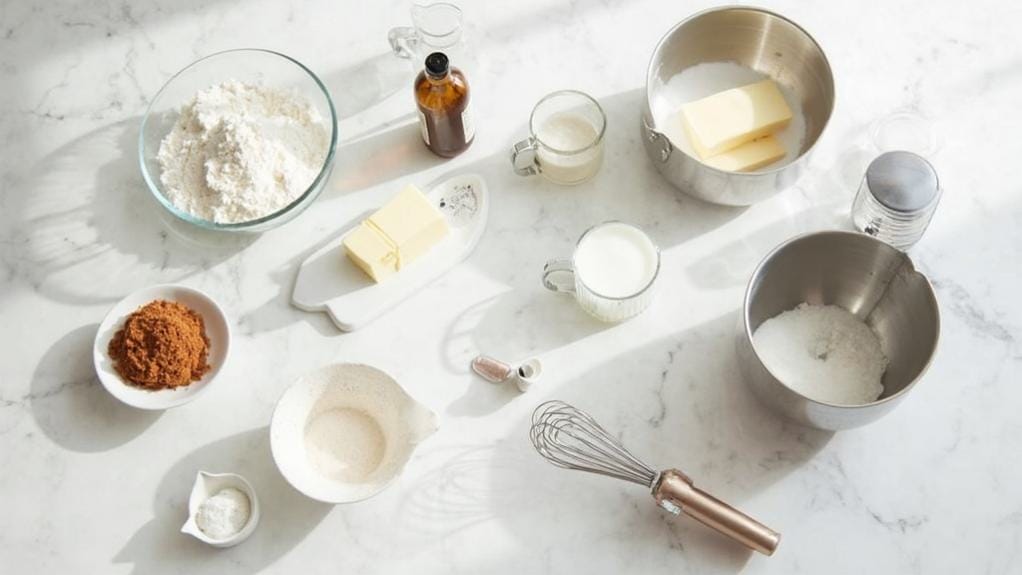
Before diving into these delightful snickerdoodles, gather two mixing bowls – one for your dry ingredients and another for creaming the butter mixture. You’ll also need measuring cups, measuring spoons, a whisk, an electric mixer or wooden spoon, and two baking sheets lined with parchment paper.
In your first bowl, measure out the 2 cups of all-purpose flour, ensuring you’ve leveled it off properly. Add 1 teaspoon cream of tartar, 1/2 teaspoon baking soda, and 1/4 teaspoon salt. Set this aside while you prepare your wet ingredients.
For your second bowl, take out your vegan butter about 30 minutes before mixing to achieve the right softened consistency. You’ll need 1/2 cup of it at room temperature.
Create your cinnamon-sugar coating in a small, separate bowl by combining 1/4 cup granulated sugar with 1 tablespoon cinnamon. Make sure you’ve measured out your remaining ingredients: 3/4 cup granulated sugar, 1/4 cup plant-based milk, and 1 teaspoon vanilla extract.
Having everything pre-measured and ready to go will make the mixing process smooth and efficient.
Step 2. Mix Dry Ingredients Together
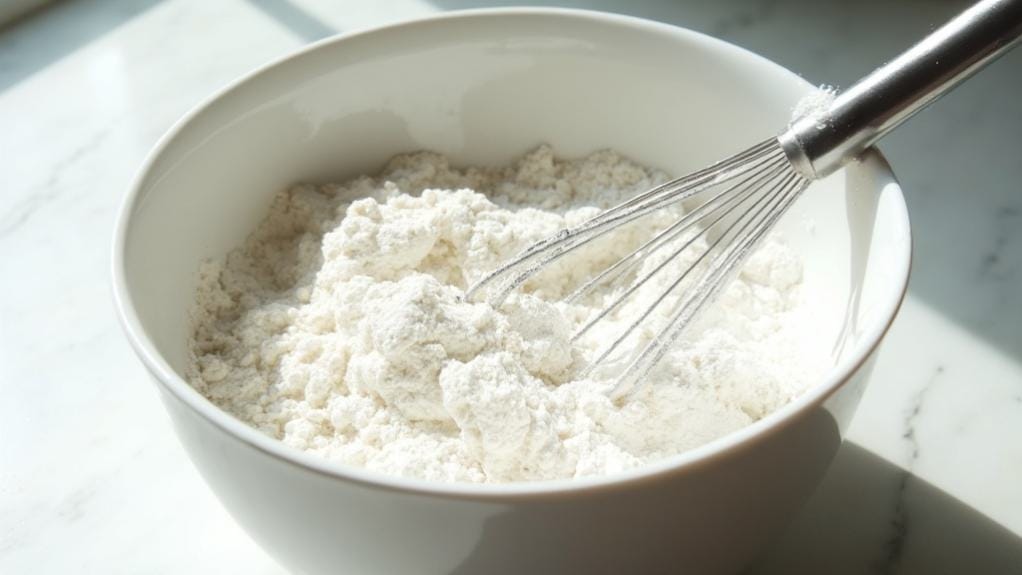
With your ingredients neatly arranged, it’s time to start the mixing process. Take out a medium-sized mixing bowl that will comfortably hold your dry ingredients while allowing room for thorough whisking. Position it on a clean, flat surface where you can easily work.
Start by measuring your all-purpose flour precisely using the spoon-and-level method – spoon the flour into your measuring cup and level it off with a straight edge rather than scooping directly from the flour bag. This technique ensures you don’t pack too much flour into your measurements. Add your measured 2 cups of flour to the bowl.
Now, add your leavening agents and salt with careful precision: 1 teaspoon of cream of tartar, 1/2 teaspoon of baking soda, and 1/4 teaspoon of salt. These ingredients are crucial for achieving those characteristic snickerdoodle cracks and proper rise.
Using a whisk, combine these dry ingredients with gentle but thorough strokes, making sure to break up any small clumps of flour or leavening agents. You’ll want to whisk until the ingredients are uniformly distributed and take on a consistent, pale color throughout.
Step 3. Cream Butter and Sugar Together
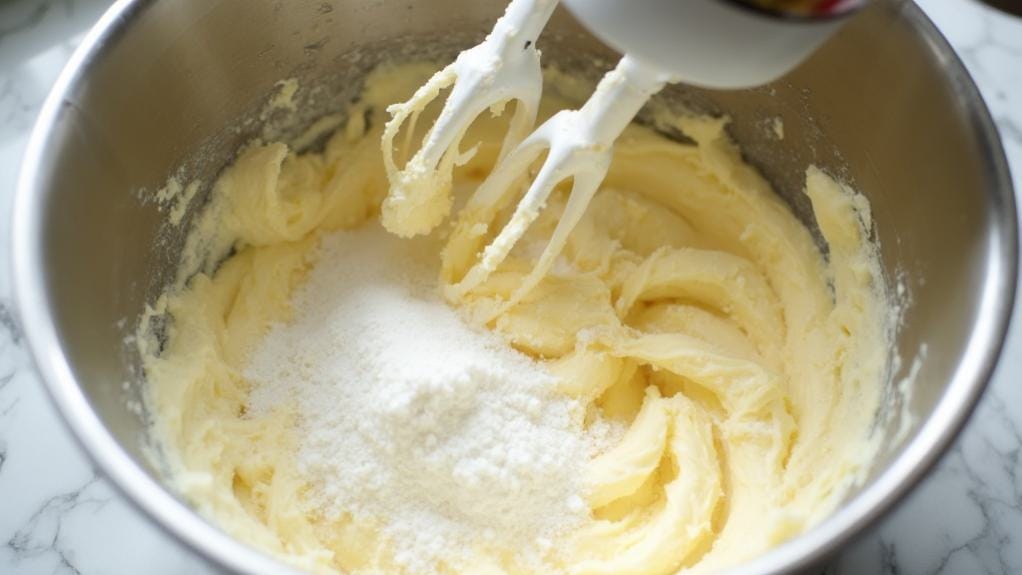
The gentle art of creaming butter and sugar together forms the foundation of perfectly textured snickerdoodles. In your mixing bowl, begin with softened vegan butter that’s just pliable enough to leave a slight indentation when pressed with your finger.
Add the granulated sugar, ensuring it’s evenly distributed over the butter’s surface.
Using an electric mixer on medium speed, start blending the butter and sugar together. You’ll want to continue this process for about 3-4 minutes until the mixture becomes noticeably lighter in both color and texture.
As you cream, pause occasionally to scrape down the sides of the bowl with a rubber spatula, ensuring every bit of butter and sugar is thoroughly incorporated. The mixture should transform from dense and grainy to light and fluffy, with a slightly increased volume.
Once you’ve achieved the proper consistency, add your vanilla extract and plant-based milk.
Mix these liquid ingredients in gradually, maintaining the creamy texture you’ve developed. Don’t worry if the mixture looks slightly curdled at first – it’ll smooth out as you continue mixing.
Step 4. Combine Wet and Dry Mixtures
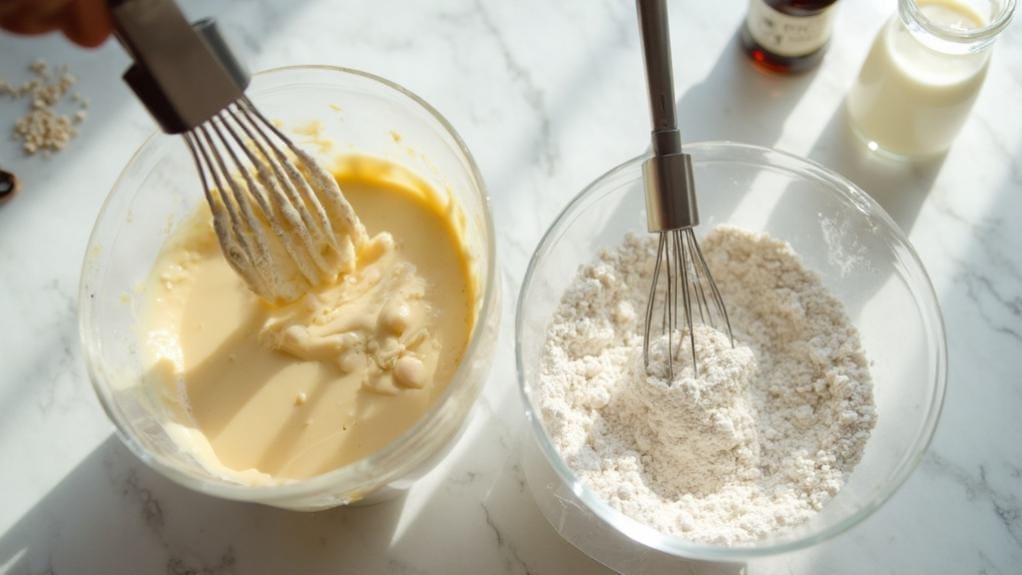
Now that your butter mixture has reached its perfect creamy consistency, you’ll need to merge it with your dry ingredients. Start by adding the plant-based milk and vanilla extract to your creamed butter-sugar mixture, ensuring they’re fully incorporated. You’ll notice the mixture might look slightly curdled at first, but don’t worry – this is normal with plant-based ingredients.
Gradually add your pre-whisked dry ingredients (flour, cream of tartar, baking soda, and salt) to the wet mixture in three portions. Use a spatula to fold each portion in gently, scraping down the sides of the bowl as needed.
You’re looking for a soft, pliable dough that holds together without being sticky. If your dough feels too wet, add flour one tablespoon at a time; if it’s too dry, add small splashes of plant-based milk until you reach the right consistency. The final dough should be smooth and uniform in color, with no visible streaks of flour.
Remember not to overmix, as this can lead to tough cookies – stop combining once the ingredients are just integrated.
Step 5. Shape and Bake Cookies
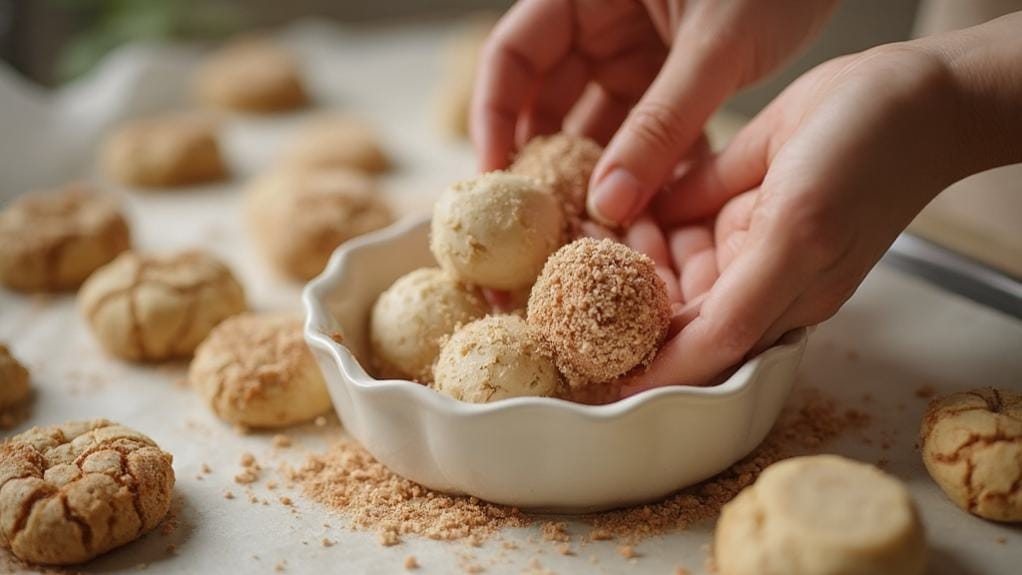
Once your dough has reached the perfect consistency, prepare your rolling station by mixing 1/4 cup sugar with 1 tablespoon cinnamon in a small bowl.
Line your baking sheets with parchment paper and preheat your oven to 375°F (190°C).
Take portions of the dough and roll them into 1-inch balls between your palms. Drop each ball into the cinnamon-sugar mixture, ensuring it’s evenly coated on all sides.
Place the coated dough balls on your prepared baking sheets, spacing them about 2 inches apart to allow for spreading. If you notice the dough becoming too soft to work with, pop it in the refrigerator for 15-20 minutes to firm up.
Slide your cookies into the preheated oven and bake for 10-12 minutes, until the edges turn slightly golden while the centers remain soft. Don’t overbake them, as they’ll continue to set after removal.
Let the cookies rest on the baking sheet for 5 minutes before transferring them to a wire cooling rack.
You’ll know they’re done perfectly when you see that signature crackled surface and smell the intoxicating aroma of cinnamon and vanilla.
Why I Love This Dish
As someone who’s been baking traditional snickerdoodles for years, I’ve fallen deeply in love with this vegan version that captures all the nostalgic charm of the original.
What draws me to these cookies is their perfect balance of textures – that signature crackled top giving way to an incredibly tender center that melts in your mouth. The aroma of cinnamon and vanilla that fills my kitchen while they’re baking never fails to bring back cherished memories of childhood baking sessions.
I especially appreciate how this recipe maintains the classic snickerdoodle characteristics while being completely plant-based. The vegan butter creates the same buttery richness I remember, while the cream of tartar provides that subtle tangy note that makes snickerdoodles so distinctive.
When my non-vegan friends try these cookies, they’re genuinely surprised to learn they’re egg and dairy-free. That’s perhaps what I love most about this recipe – it proves that going vegan doesn’t mean sacrificing the comforting flavors and textures of beloved traditional treats.
Each batch I bake reinforces why these cookies have become a staple in my kitchen.

Leave a Reply